Inside the New ‘Museum of Broadway,’ a Musical Theater Fan’s Paradise
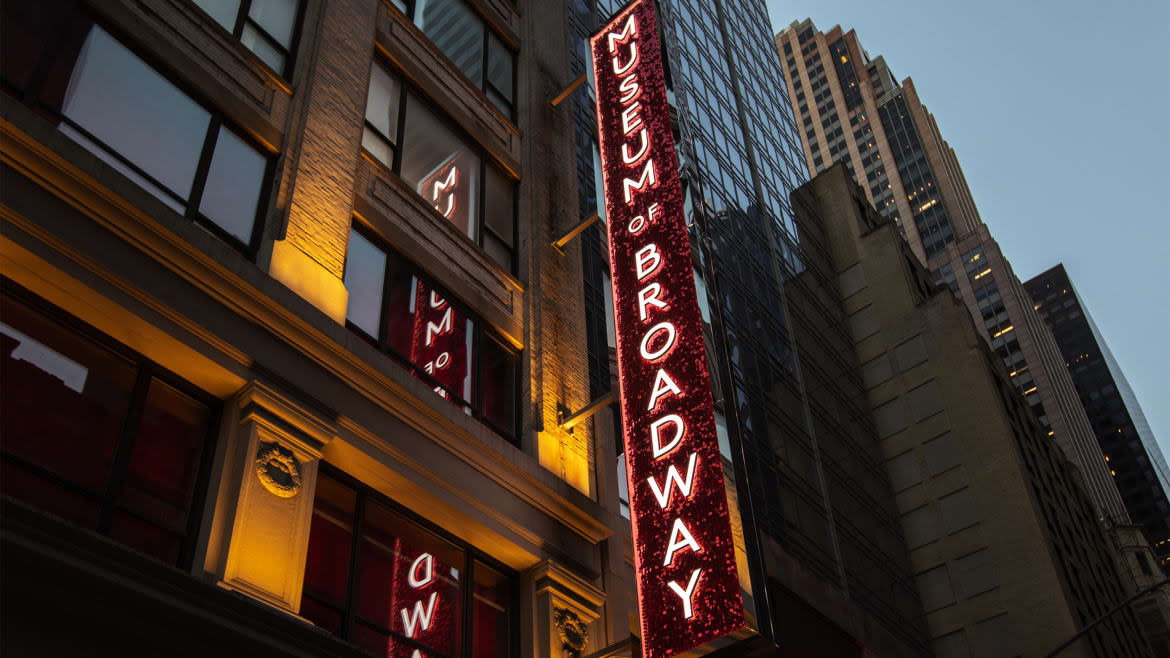
- Oops!Something went wrong.Please try again later.
- Oops!Something went wrong.Please try again later.
- Oops!Something went wrong.Please try again later.
- Oops!Something went wrong.Please try again later.
The letter is dated September 26, 1957, and begins, “Dear Lenny, You know—only too well—how hard it is for me to show gratitude and affection, much less to commit them to writing.”
The letter, from Stephen Sondheim to Leonard Bernstein, was written on the day of the legendary musical West Side Story’s Broadway premiere, and can be seen in an un-showy glass case in the “West Side Story” room of the Museum of Broadway, which opens tomorrow, Nov. 15, at 145 West 45th Street, just a hop and a skip from Times Square.
As the letter’s presence indicates, this new museum—a kind of zigzaggy warren, spanning 26,000 square feet across four floors—is a musical theater lover and nerd’s paradise. As for plays, they are given full and equal consideration on the many information boards, but considerably less love when it comes to the room installations and displays.
Up Close and Very Personal With the Real Stephen Sondheim
Informative and involving, the museum tells the story of Broadway theater from the first play performed in New York City in 1732 to the present day on detail-rich panels. Then, displays of objects and theatrical ephemera and specially designed rooms, reveal how Broadway musical theater came to be, and how musicals themselves are made. All bar one of these specially designed rooms are devoted to musicals, rather than plays. The imbalance perhaps speaks to reflex expectations of what “Broadway” means—musicals above plays—but should a “Museum of Broadway” be treating both so unequally?
The “West Side Story” room includes a full mock-up of Doc’s counter. Other rooms are devoted to musicals including HAIR (with psychedelic illustrations and costumes), Company (with its neon and silver balloons spelling out 35 for Bobby’s birthday), Show Boat (the centerpiece is a flowing sculpture of the show’s script), Oklahoma! (yes, a mocked-up cornfield is on display), and Rent (which features a convincingly arty urban milieu, as well as correspondence from creator Jonathan Larson).
Other areas feature Funny Girl, Fiddler on the Roof, and The Phantom of the Opera. There are videos, costumes, models, and a suitably theatrical section devoted to backstage life and “the making of a Broadway show.” Original cast recordings from every show pipe forth from its own room, beginning with “Ol’ Man River” in the Show Boat room, “Oh, What a Beautiful Mornin’” in the Oklahoma room, “Aquarius” from Hair, “Company,” in Company, and “Seasons of Love” from Rent. One thing that can be guaranteed: you will leave the Museum of Broadway humming.
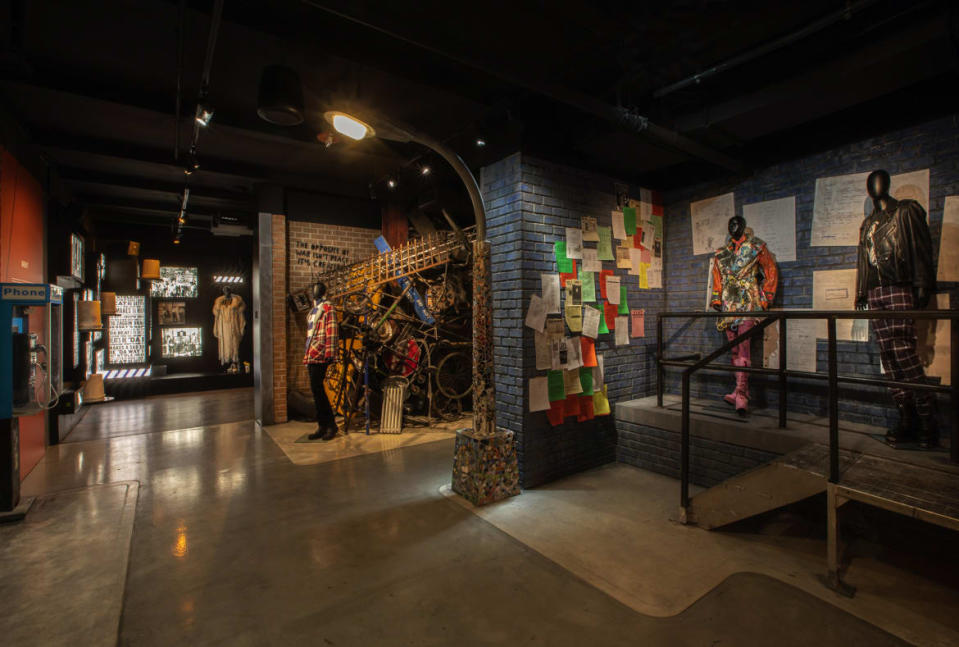
Rent and Bring in 'da Noise, Bring in 'da Funk exhibits.
Co-founders Julie Boardman and Diane Nicoletti hope the museum “will become a place that provides education and inspiration by way of a uniquely immersive theatrical experience.” They say they conceived the museum “to honor Broadway: its legendary history, its brilliant creators, its tireless sustainers, and its invaluable supporters; and we built it for the fans and community to have a place to gather and celebrate.”
This they have achieved, although the museum also feels incomplete in some ways. You might say that this production—involving, and delightfully and creatively executed as it is—also feels a little rushed to the stage. The over-concentration on musical theater, at least in terms of what occupies floor space, feels glaring. The panels tell dramatic theater’s history in equal detail to musical theater history, but why give the specially designed installation space to mostly musical theater productions—apart from a room for Angels in America, and a display devoted to the Public Theater, which includes Meryl Streep’s debut Broadway costume from Trelawny of the “Wells” (1975).
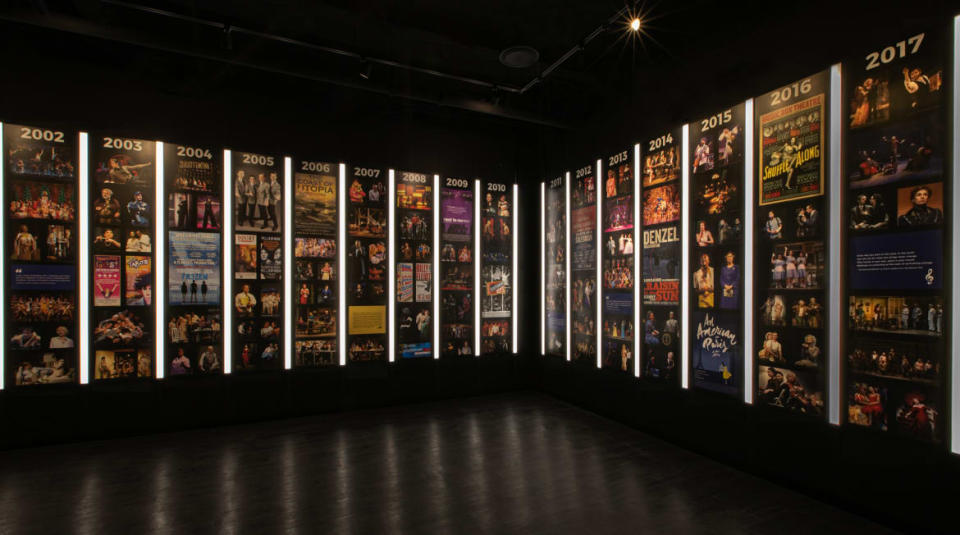
Timeline Wall.
While a cornucopia of many pleasures (which should take you around 60-90 minutes to orienteer; timed tickets are $39, and children under 4 can enter free of charge), the museum is chronological, each new section heralded by a panel detailing the key historical moments of any given period.
The first special exhibit is a room of Hirschfeld illustrations of luminaries (including Streep and Liza Minnelli) curated by David Leopold, creative director of the Al Hirschfeld Foundation, and which includes an ingenious gizmo which allows you to create “your own Hirschfeld”—meaning you can go to town illustrating a face with his trademark bushy eyebrows and springing strands of hair.
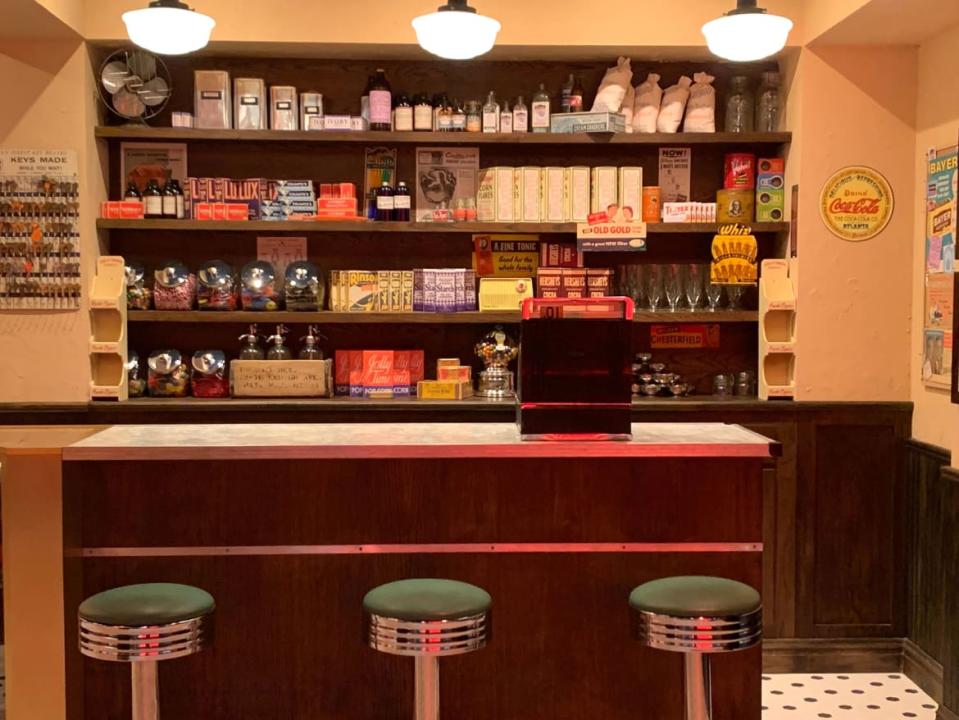
Doc's counter in the 'West Side Story' room.
A room of Playbills heralding the most recent crop of shows gives way to an opening video showing the evolution of New York theater, spreading uptown from its inception in the 1730s in the Financial District and Chinatown. The geographical Broadway we know today originated in the late 1890s. Broadway’s cycles of Golden Age, decline, and rebirth are sketched. Completists may find gaps in what is being told, but the curators, led by Ben West, succeed in both conveying a rich history as fully as possible—paying particular attention throughout to the evolution of Black-made art on Broadway—as well as a treasure trove of fun and engagement. It’s a little theme-parky, yes, but in the best possible—which is to say, devotional—way.
Unlike so many museums, the panel information—a riot of words, vintage pictures, posters, and programs—is fascinating, and may detain you longer than expected. The museum shows how, in the 18th and 19th centuries, “as a new nation began to develop its cultural identity, the European influence on the American stage remained strong.” The work of Ibsen, Shaw, and Wilde dominated.
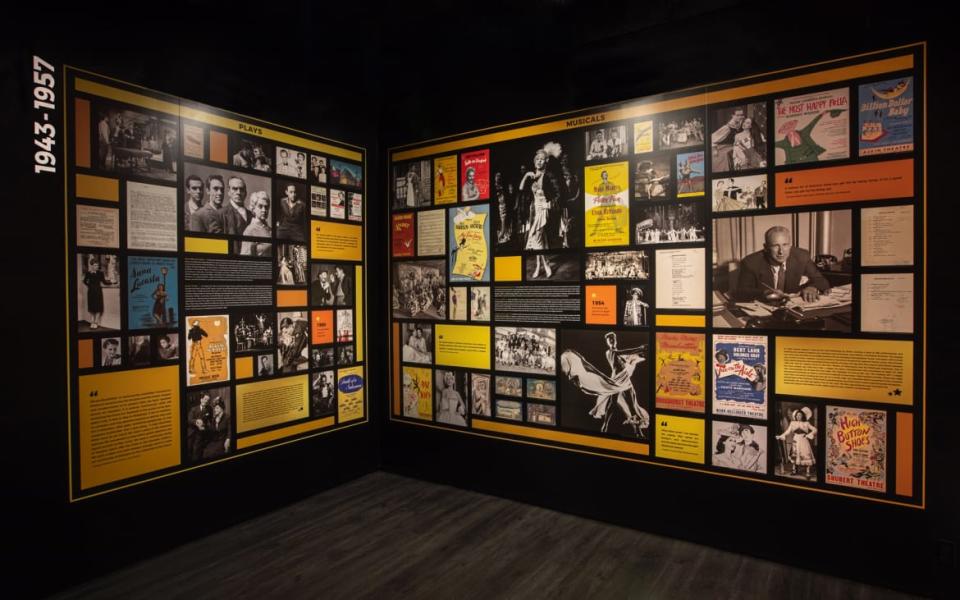
In this room and others, especially into the present day, this visitor would have welcomed the video or aural presence of Broadway stars and/or other major players to tell the Broadway story itself.
American playwrights emerged on Broadway in the early 20th century with the trail blazed by Augustin Daly, William Dunlap, Bronson Howard, and David Belasco (who has a theater named after him). The American musical emerged from a “dizzying array of disparate, embryonic modes,” encompassing T.D. Rice’s burlettas, Laura Keen’s varied entertainments, and Edward Harrigan and Tony Hart’s musical plays.
Burlesque rose in popularity, and the city’s “first seismic commercial success” was a spectacle named The Black Crook (1866). Anne and Emma Hyers, Bert Williams, George Walker, and Bob Cole led the first generation of Black Broadway artists.
Potted histories of major and now forgotten figures like George M. Cohan are provided, alongside the history of minstrel shows, vaudeville, and, in the first major themed room, the Ziegfeld Follies—like every room, a concise history also designed with the needs of Instagrammers in mind, with a lot of feathers, spangles, and neon.
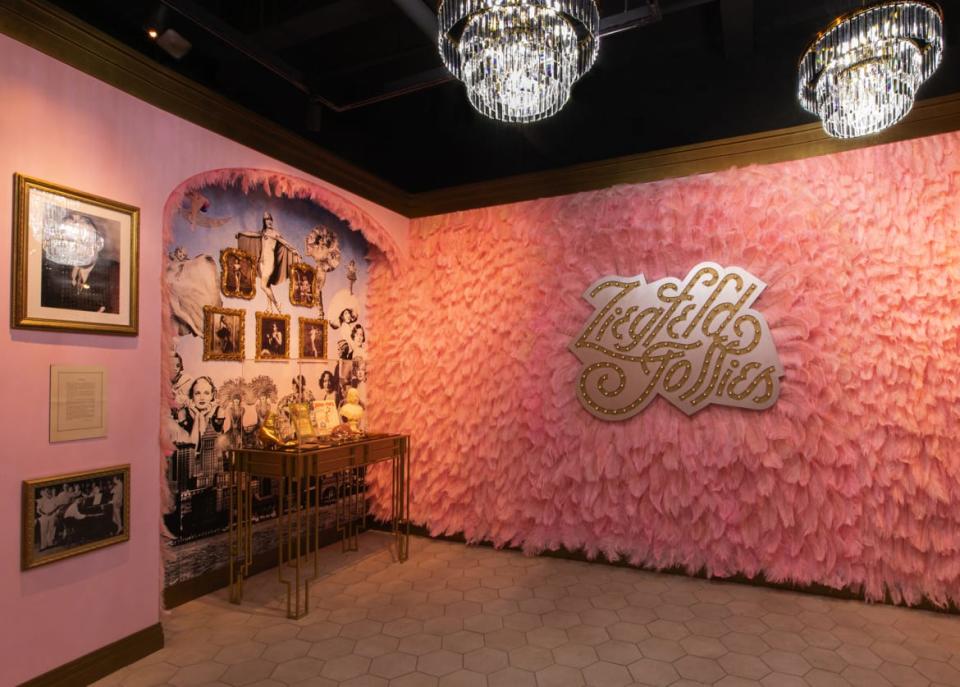
Ziegfeld Follies.
The museum balances the grand sweep of history with individual vignettes, echoing a wall quote by playwright Lynn Nottage about the power of theater itself: “The more you go to the theatre and the more you hear stories that you aren’t necessarily familiar with, the more open you become to embracing other perspectives.” One panel about the 1920s includes the influence of the “jazz-infused boom” of that era in Black theater, as well as the story of racy social satire, Tangerine (1921), alongside the rise of female playwrights and practitioners like Susan Glaspell and Clare Kummer, the Little Theatre Movement, and new dramatists such as Eugene O’Neill.
The explosion of musical experimentation is heralded by the work of Howard Dietz (The Little Show, Three’s a Crowd, and The Band Wagon), alongside the more edgy experimentation from the 1930s and 1940s of Marc Blitzstein’s The Cradle Will Rock, Moss Hart’s Lady in the Dark, and Brecht/Weill’s The Threepenny Opera; that panel includes a story, once told by Hart, of how he and Weill conceived Lady in the Dark.
The museum takes you through World War II, Porgy and Bess, and on into the '50s and '60s, the panels becoming so crowded with the volume of work and detail that the curators break them down into plays and musicals. There is the beginning of the Tony Awards in 1947, and the rise of figures like Hal Prince.
The “West Side Story” room includes not just Sondheim’s letter to Bernstein, but also pictures of the original cast and original Playbill, and a fun interactive dance component. An interactive Sondheim “anagram puzzle” pays tribute to his love of puzzles.
In Hello Dolly-land, delight in the resplendent red outfit worn by Bernadette Peters in the role. Pay attention to the little display cases—they hold original annotated scripts, jewelry, shoes, scraps of notes from writers to themselves, and alongside them on the wall are quotes from the leaders in their particular fields, like Gower Champion, director and choreographer: “You use the bodies of dancers as instruments, like the keys on a typewriter, to tell a story. I hate dancing for the sake of dancing in a show. It should be used to aid the story line.”
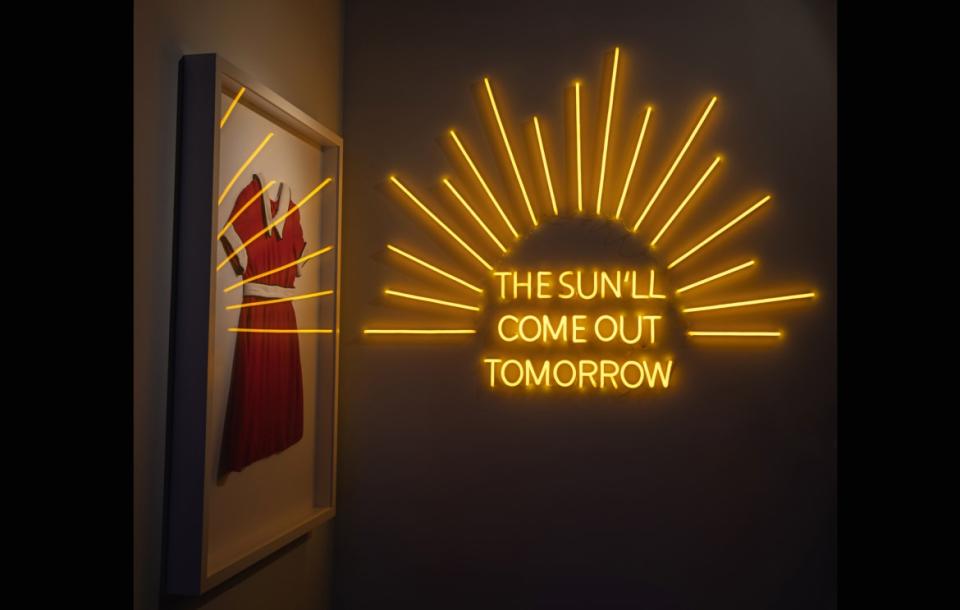
Annie.
The museum shows how the civil rights era and the revolutionary energy of the '60s and '70s landed on Broadway, just at a moment when Times Square itself was in a state of disrepair, and then—amid “a prolonged period of discord and disarray”—the emergence of blockbusters like Jesus Christ Superstar, Chicago, The Wiz, A Chorus Line, and Annie alongside the rise of the Public Theater. Into the '80s and '90s, the museum feels a little more hurried, although—centered around Angels in America—there is a meditative space dedicated to the impact of AIDS on Broadway, including sections of the memorial quilt, and a quote from Larry Kramer: “AIDS was allowed to happen. It is a plague that need not have happened. It is a plague that could have been contained from the very beginning.”
The Rent-dedicated space includes a letter Larson wrote to Sondheim explaining his thinking behind the show: “I do see homeless, drug users, HIV+ people, homosexuals and liberals lumped into this one demographic ‘them’—who have replaced the Communists as the Right’s fear-poster boys. My aim is to humanize and celebrate this kind of ‘otherness,’ so that although the audience may be put off by some of these characters at first, they come to care about them since their love stories are universal.”
The display also includes Larson’s application for a Phase 1 New American Works Grant from the National Endowment for the Arts, sent on August 17, 1992, in which he writes: “I’m 32 and support myself primarily by waiting tables.” Now, in his name, the Jonathan Larson Grants program supports artists just like him.
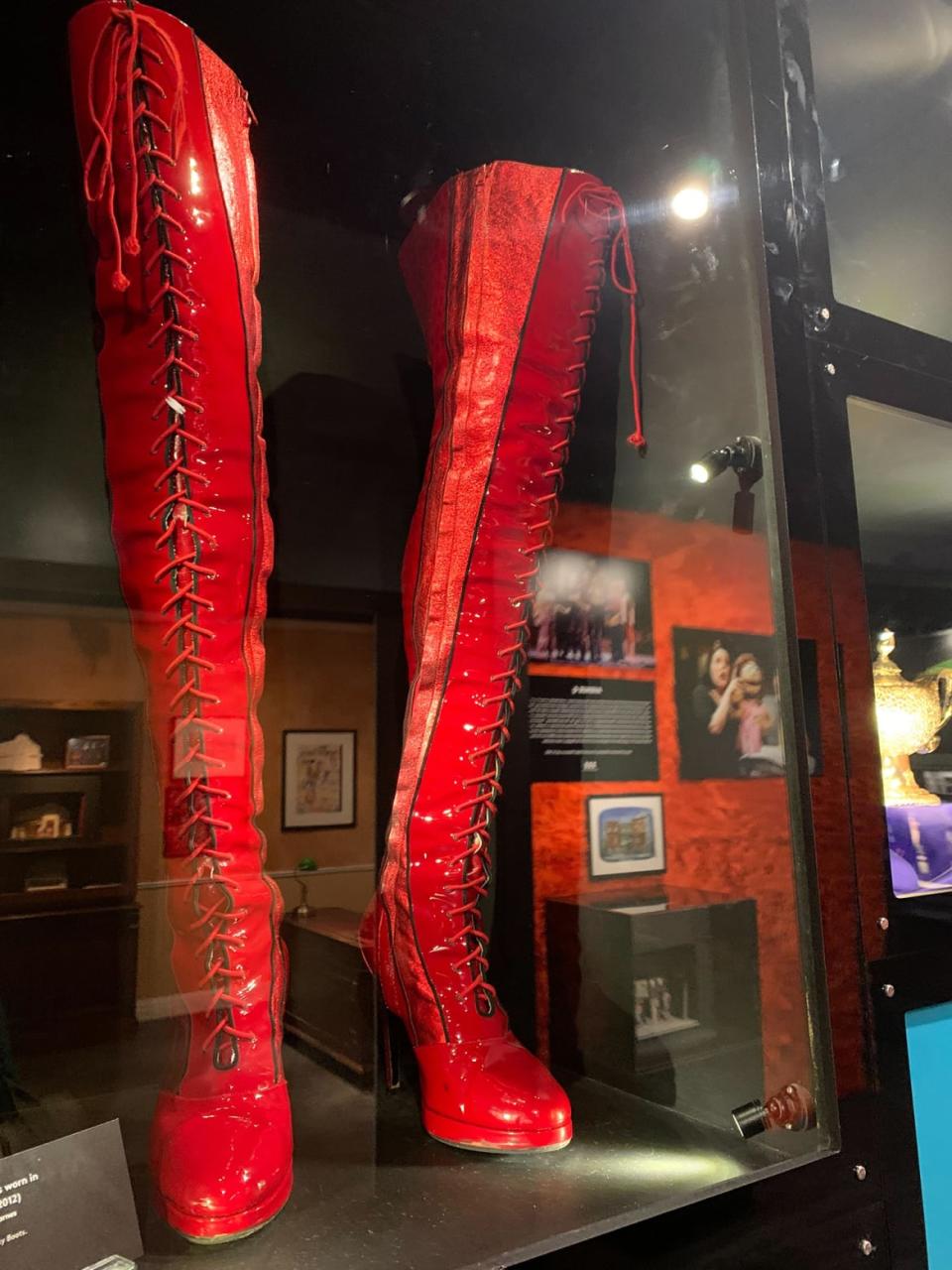
'Kinky Boots' boots.
Onwards the visitor heads through sets and costumes from Bring in 'Da Noise, Bring in 'Da Funk, The Lion King, The Producers, Kinky Boots, Wicked, and Hamilton. Unseen or currently missing (the final parts of the exhibit were still being completed when this writer visited) are considerations of how the COVID pandemic affected and continues to affect Broadway, and the race and racism-related activism—and results of that activism—which followed the murder of George Floyd.
A room or display devoted to the incoming and future talent of Broadway, its new and current and next generations of performers, playwrights, composers, and other creators would point to the future. There should generally be more room and installation space given to significant plays to match the colorful coverage of musicals.
More interactive elements (this is going to be a theater nerd paradise; so bring on the quizzes) would be welcome, more visibility of standout stars and icons (maybe in a dedicated display of their own) would be welcome. How about a display or room dedicated to the history of the Broadway diva? Surely, some kind of karaoke or interactive experience, giving the theater fan their chance to belt alongside Patti LuPone or run lines opposite Meryl Streep or Denzel Washington, would go down a storm.
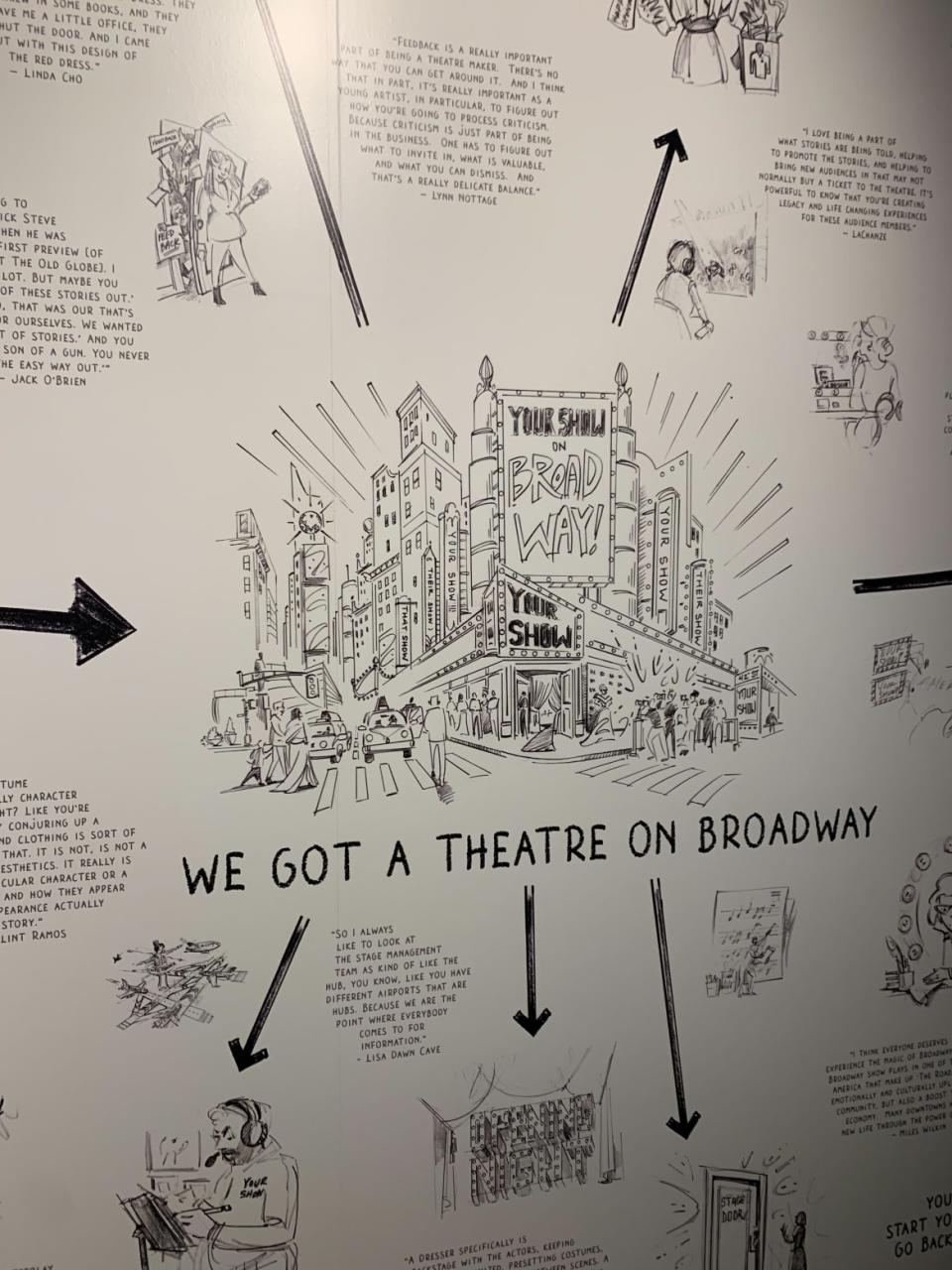
Videos of epic performances (dramatic and musical), displays of the biggest little-engine-that-could successes as well as the biggest flops, could also find a home, as well as spotlighting more stage performances and Tony Award performances that have delighted fans.
An immersive, sprawling installation designed by David Rockwell ends the experience. “The Making of a Broadway Show” is precisely that—both a backstage tour of what everyone does sight unseen to get the performers on stage, from costumes and make-up to sound and lighting, while also illustrating the marketing and PR necessary to elicit interest and attendance from audiences. The wittily illustrated flow charts of a “life cycle” of a Broadway show are the most revealing of all—a truthfully brutal narrative of art and economics laid bare under a series of arrow-strewn section headings: from “Let’s write a show” to “Build the creative team” to “Build a show” to “Out of town,” to “We got a theater on Broadway” to “Life after Broadway.”
After this eye-opening, no-holds-barred illustration of the snakes-and-ladders madness of mounting a Broadway show, the Hirschfeld room provides a whimsical opportunity to draw breath before leaving, and humming your heart out. Just this once, as you walk through its throngs, Times Square seems bearable.
Get the Daily Beast's biggest scoops and scandals delivered right to your inbox. Sign up now.
Stay informed and gain unlimited access to the Daily Beast's unmatched reporting. Subscribe now.

